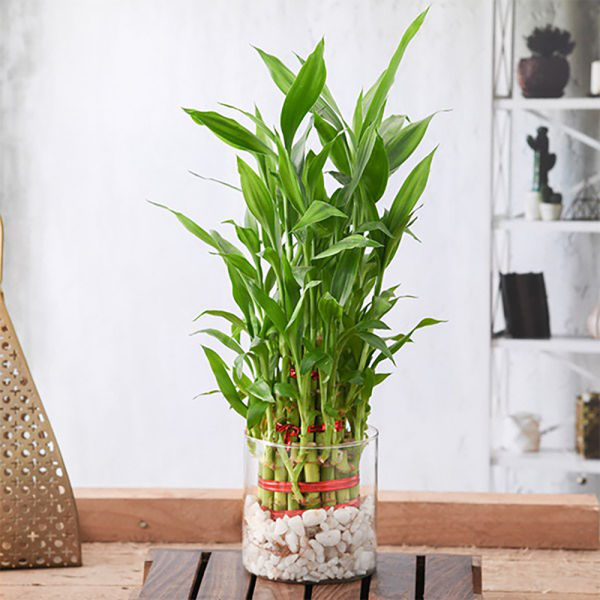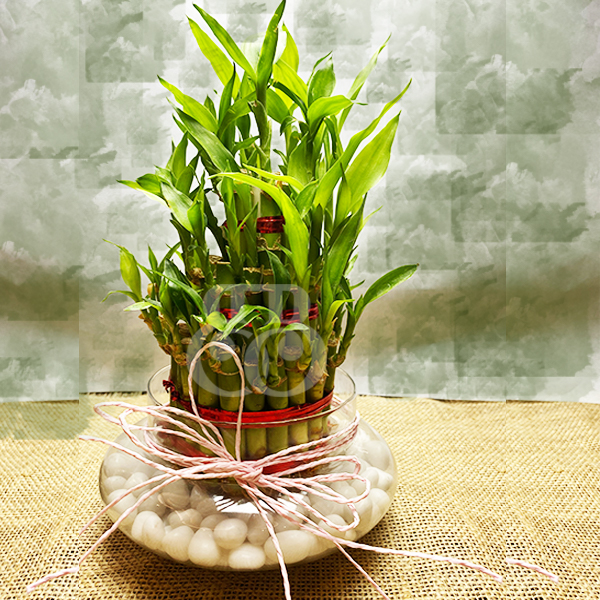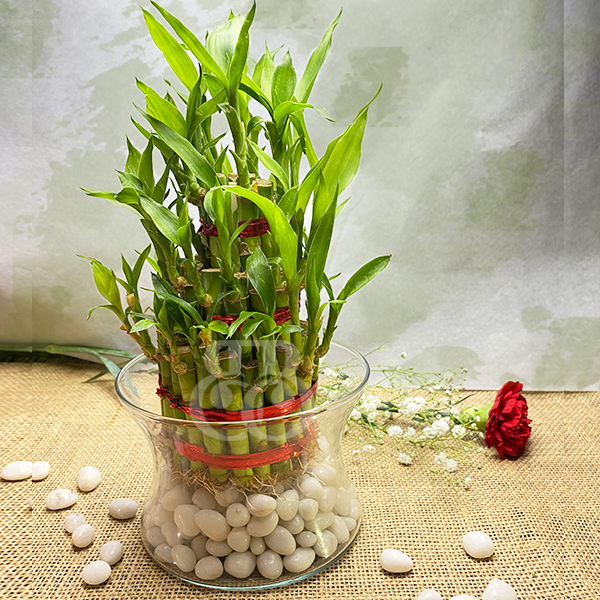
Lucky Bamboo Plant
Bamboo plants are considered incredibly fortunate and auspicious in both Vastu Shastra and Feng Shui. Having bamboo plants in your office or home is supposed to increase your financial success and prosperity. Through selective breeding and other methods, bamboo plants have been modified for use as houseplants.
These days, you can buy bamboo plants in a wide range of sizes and forms, from miniature “friendship plants” formed by stacking bamboo logs and tying them together with a red ribbon to taller plants with thicker stems and leaves that require a larger glass vase filled with water, pebbles, and stones. Various varieties of lucky bamboo can be found in nurseries and novelty stores alike. According to Vastu Shastra, the lucky bamboo plant should be placed in the east or southeast corner of the house
Some Fascinating Facts About the Bamboo Plant

Bamboo plants (Dracaena sanderiana) are members of the Asparagaceae plant family. Its beginnings can be traced back to Southeast Asia some five thousand years ago. Lucky bamboo usually has two, three, or seven tiers. However, when fully mature, it can reach a height of 3 to 5 feet and a width of 2 to 3 feet. Position the plant where it will receive indirect sunlight. The soil has to be damp.
Benefits of keeping a bamboo plant.
The bamboo plant, native to south and southeast Asia, is one of the easiest houseplants to care for. It’s a tropical water lily variety that’s quite popular with humans thanks to its many benefits:
· Bamboo helps maintain a clean environment and has natural air-purifying properties.
· It is said that having a lucky bamboo plant in your house would bring prosperity and good fortune.
· The direction of low, indirect light is ideal for growing bamboo. The average lifespan of a bamboo plant is about 10 years when given clean water and plenty of sunlight.
· The sleek, elegant appearance of the plant’s stems complements the decor of any home.
· In addition to providing positive energy, the lucky bamboo plant is also supposed to protect its owners.
· Keeping the lucky bamboo plant towards east is thought to bring prosperity and good health to the household. Keeping it towards southeast will bring you luck and wealth.
· The nutritious qualities of bamboo shoots are only one of the plant’s many benefits. Iron, phosphorus, magnesium, fibre, and amino acids are just some of the nutrients it provides.
· The bamboo plant also has anti-inflammatory properties.
· Because of its versatility, bamboo makes a great material for home furnishings and decorative accents. Besides being utilised for its leaves and flowers, bamboo is also valued for its long stems, which may be fashioned into a variety of constructions such as fences, pillars, bridges, floors, and roofs.
You should take careful care of your lucky bamboo plant because of the various advantages it can bring you. If you put the plant in the right spot and water it regularly, it will bring you good fortune.
Benefits of lucky bamboo: Why are bamboo plants regarded as lucky?
The Feng Shui community generally considers bamboo to be a lucky plant. According to Feng Shui, the hollow structure of the plant facilitates the flow of Chi energy. The bamboo plant is believed to increase wealth and success by promoting the free flow of positive energy. The plant’s pipelike structure also reflects the wisdom that comes from understanding how to channel your energy forth rather than keeping it bottled up inside.
If you want to follow Vastu guidelines, where should you put your lucky bamboo plant?

It is recommended that you place the lucky bamboo plant in the eastern part of your home. Keep the bamboo plant in the southeast corner of your home to attract wealth and success. It is believed that if you keep it here, you will be able to go through tough financial times and achieve success.
Bamboo plants placed in the centre of a table are said to bring good fortune and prosperity to the household.
Bamboo plants are acceptable decor for bedrooms. Because of its low light requirements and ease of care, bamboo is a great addition to the bedroom.
The growth and fresh beginnings that lucky bamboo represents, as well as the family peace and harmony it fosters, are all symbolic of good fortune. Keep it near your front door to bring positive energy into your home.
Additionally, bamboo plants help clean the air and get rid of harmful chemicals. Simple to care for, they can grow to a height of three feet.
Don’t let the plant get too much sun.
Various names for lucky bamboo
In feng shui, the Dracaena Sanderiana species is considered a good omen. Species in this family are known as asparagus. Numerous other names have been given to this fortunate houseplant, including Chinese water bamboo, Friendship bamboo, curly lucky bamboo, Belgian evergreen, Goddess of Mercy, and Sander’s Dracaena.
Bamboo planter pots
Lucky bamboo can be grown in a wide variety of containers, including ceramic and porcelain pots, shallow dishes, glass bowls, a jar, and tall vases, depending on the size of the bamboo. If you opt for a low dish or bowl, allow at least an inch of extra space around the edges so the roots have room to grow.
It’s best to keep the lucky bamboo plant in a transparent container so that you can see the roots. Each of the five elements—wood, metal, water, fire, and earth—must be present in this vessel.
If you want to put these things in the container, here’s a straightforward way to do it:
Methods of Components
- Pebbles – Put some dirt in the planter.
- Metal – Put some cash in the jar.
- The stem stands in for the wood element.
- Add some water to the cooking vessel.
- Use a red ribbon or band and tie it around the plant to represent fire.
Bamboo can be planted everywhere because it doesn’t need a lot of water. If you put them in a body of water, make sure the water stays above the roots. Soil must be maintained consistently moist if you’re cultivating it. However, be sure you don’t over-water it.
Yellow or dark green stalked bamboo plants should be avoided. To avoid contamination, do not use chlorinated water to fill the container. Tap water is better because it already includes minerals. Water should be changed out every week to maintain health.
Even though bamboo plants are low-maintenance and adaptable, you should always take safety measures. When it comes to encouraging growth and positive energy, nothing beats a plant that looks like it’s in good health.
A monthly application of a liquid houseplant fertiliser is also useful for deterring pests. When the bamboo outgrows its container, remove its golden leaves and repotted it.
Read More: Glacier Cake in Bangalore
What is the procedure for propagating fortunate bamboo cuttings?
If the bamboo plant is grown too tall, prune a sprout from the main stem an inch above a node. The branch should have at least two leaf tips. A few weeks after the stalk is cut, it can be planted in a basin filled with two inches of water. A few pebbles dropped into the plant’s water bowl can help maintain equilibrium.
Common varieties of houseplant-friendly bamboo.
Lucky two-tiered bamboo plant
Direct, filtered sunlight is ideal for growing bamboo. While two-layer lucky bamboo plants can thrive in well-drained soil, it is more common to see them kept in glass vases with stones and water.
Lucky three-tiered bamboo plant
Because of its hardiness and tolerance of poor lighting, this species of bamboo requires less care and attention. The majority of Indian households keep at least one of these types of plants inside.
Seven-layered bamboo, a plant of good fortune
It’s one of the easiest plants to care for, thus people often offer it as presents. It brings prosperity and calm to the house or office. Avoid root rot by using filtered water and changing the water once a week for your seven-layer bamboo plant.
The proper way to tend to a bamboo plant. To care for the bamboo plants, follow these guidelines:
- When exposed to bright light, lucky bamboo grows rapidly. It can survive in dim light, but its growth will be stunted.
- Keep away from the water supply if you notice it’s hard. You’ll have considerably more success growing fortunate bamboo if you use distilled or pure water.
- It’s important to never let the roots of your lucky bamboo dry out, so be sure to keep some water at all times around them.
- Keep the water level low enough that only the roots are submerged, and don’t let it get too high.
- Keep the lucky bamboo plant at least a foot away from any heating or cooling vents. Don’t let it get exposed to any draughts, either.
- Do not let dust accumulate on the leaves; this will prevent the plant from being able to breathe through its pores. Brushing the leaves with a damp cloth or spraying them with water might help keep them healthy.
- Tie a bow around each stem to keep it in place. Thus, there is no longer any danger of your plant tipping over from its own weight.
- If the container your bamboo is in becomes too small, you may need to replant it.
- It’s important to wash the pebbles and carefully remove the bamboo plant from its current pot before repotting it. To plant the bamboo, first fill in the area around the plant’s roots with pebbles. Don’t let the water get too high; you want it to cover the roots but not soak the bamboo stalks.
- If you’re planting your lucky bamboo in soil, make sure the container has good drainage.
- Even while lucky bamboo plants do best in moist soil, drowning them can stunt their development.
- Only until the top inch of soil is dry should it be irrigated.
- When it comes to Feng Shui, bamboo is a symbol of good fortune.
Believe it or not, having bamboo plants in the home might help you relax. People want to keep it because it represents freedom and adaptability in the workplace. The bamboo plant arrangement also symbolises the five elements of earth, the basis for a peaceful cosmos.
When and how should bamboo be cut back to shape it?
When you prune a plant, you are shaping it in addition to removing dead branches. Trimming is the process of removing dead or diseased parts of a plant in order to encourage new growth as the plant ages. When the top of the fortunate bamboo plant becomes weighed down by an abundance of leaves, use sterilised scissors to cut off any lateral branches that are more than an inch from the plant’s base. Carefully snip off the branches, but leave the main stem intact. Lucky bamboo needs regular trimming to keep it healthy and growing strongly. Remove any stems that are abnormally long, thin, or growing in an unusual shape. This will foster the development of new vegetation and enhance the visual appeal of the region.
Lucky bamboo plants for the home
Right now, you can find lucky bamboo plants in many attractive and modern types. You can twist or braid the stems of a fortunate bamboo plant into spiral shapes by controlling the amount of sunlight it receives. The lucky bamboo plant can be shaped in a variety of ways, such as a twirl, heart, tower, or braid. A tower of lucky bamboo can help bring good fortune and prosperity to your home. Braided bamboo is said to bring success in business. The lucky bamboo woven trellis helps to block negative energy.
Problems with, and pests and diseases to, lucky bamboo trees
Common pests
The lucky bamboo is frequently attacked by mealybugs and fungus. If the bamboo has a grey fuzz all over it, it likely has a fungal problem. Remove the diseased part and ensure the stem and leaves remain dry.
Nim oil or alcohol can be used to get rid of the little white mealybugs.
Spider mites, tiny parasites that spin webs on plants and leave behind dark brown or black spots, are a common source of this damage. If spider mites are affecting your bamboo plant, you should regularly rinse it with cold water. Apply a little misting of soapy water to the area. Neem oil should be brushed onto the leaves.
There are problems with leaf yellowing and other aspects of the environment.
There is either too much chlorine in the water or too much direct sunlight when bamboo leaves get a brownish colour. Dampen the leaves and cut down on the sun exposure. Use filtered water instead of tap water and replace the water periodically.
According to Vastu, the indoor bamboo tree should be lush with greenery. As soon as you notice any yellowing on the leaves or stem, you know the plant is sick. The removal of these spots will stop the yellowing from spreading to the rest of the plant.
The Multiplication of Algae
If the plant is kept in a container that permits light in, algae growth will be encouraged. Clean the vase frequently with water and a mild detergent. A hidden pot is another option for housing the plant.
Tips for Interior Decoration: Blessings-bestowing bamboo
Any room could benefit from the aesthetic value of a fortunate bamboo plant.
The lucky bamboo pot or a separate tray can be dressed up with the addition of stones, coloured marbles, colourful pebbles, gravel, or shells.
Create a tranquil environment by lighting candles from crystal gem trees, placing a meditating Buddha statue in the area, or placing lamps near the lucky bamboo.
Follow the bamboo plant’s Vastu principles when designing the home’s interior.
I was wondering if you sold bamboo plants.
The decision to purchase a lucky bamboo plant for one’s own usage may be one that many people give serious thought before making. It is believed that the luck associated with bamboo plants is only transferred when the plants are given as presents. Even if you decide to bring a lucky bamboo tree into your home, none of these beliefs will come true.
Get More: Best Zamia Plant in Bangalore
